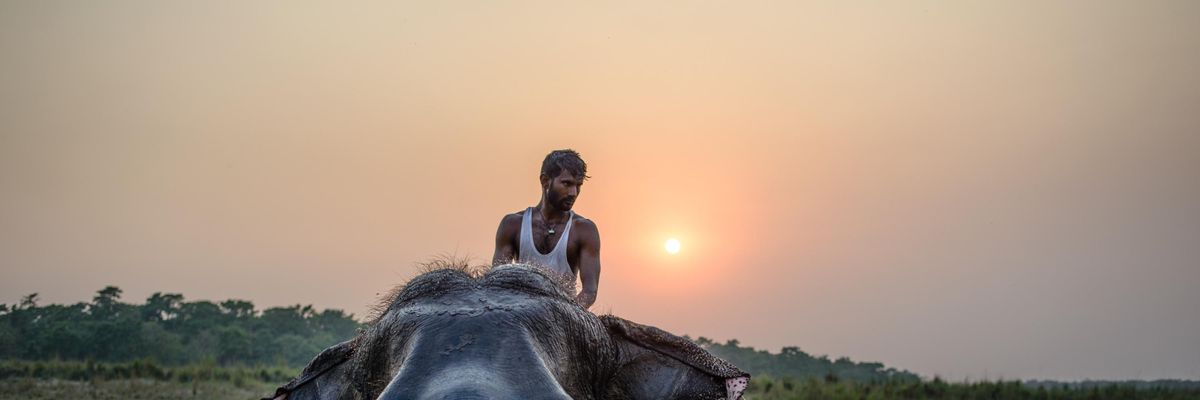Chitwan National Park in the Southern lowlands of Nepal is famous for its one-horned rhinoceros and other wildlife living in its tropical grasslands and forests. Adjoining India, this landscape was once famous as the hunting grounds of big game and entertained Royals and important government officials working for the British empire. Before the early 1960s, Indigenous Tharus occupied this land. This changed with the eradication of malaria which encouraged a massive migration from the hills, leading to deforestation and large shrinkages of the forest. Due to this deforestation and decline in wildlife, the government established its first Protected Area, a rhino sanctuary, in the 19th century to protect the one-horned rhinoceros with park rangers. These rhino guards demolished thousands of Tharu houses, forcing them to leave their land in order to make way for the newly established sanctuary.
Like most Indigenous peoples, Tharus had a spiritual connection with nature and the forest. They revered rhinos and tigers with the belief that they are vital for a healthy ecosystem.
Before the eradication of malaria and mass migration, Indigenous Tharus managed the Chitwan's forest without the need for legislation or military enforcement. During this period, Chitwan was a mix of lush forest and grassland because Indigenous life is rooted in nature conservation. It is estimated that there were more than 1000 rhinos and 300 tigers in Chitwan alone. Like most Indigenous peoples, Tharus had a spiritual connection with nature and the forest. They revered rhinos and tigers with the belief that they are vital for a healthy ecosystem. Elderly Tharu landowners tell the story of a much better forest when Tharus were managing it. Wildlife was part of life and human-wildlife conflict was negligible.
Nepal's first Protected Area, Chitwan National Park, was built under a strict protectionist idea of conservation, viewing people as the enemy of conservation. This view restricted people from the park. Consequently, the military was mobilized to shield and prevent people from accessing it. Park officials would go to extreme measures to ensure this, including burning Indigenous houses and even torturing inhabitants to death.
Timelines and data, however, don't show any evidence of militarization bettering the forest or increasing the wildlife population. In fact, the forests and wildlife habitat, have decreased. The Rhino Census 2021 showed that the total rhino population in Chitwan was 752--significantly less than the estimate before militarization.
Apart from decline in wildlife, the militarization of conservation has brought conflict between park and people. Soldiers have issued sanctions, sexually harassed, and even tortured local Indigenous people to death (See Kathmandu post, Naya Patrika, Peter Gill). These Indigenous people, who share a rich history and culture with the forest and have been harvesting its resources sustainably, now don't feel any ownership. The park doesn't encourage the participation of locals in forest management, worsening the park-people conflict even further.
There are several incidents of human rights violations taking place in the name of conservation by the soldiers and rangers. To make matters worse, big conservation organizations have worked to hide these incidents. Raj Kumar Chepang, aged 24, was beaten to death by soldiers for collecting snails in the National Park in 2020. Shikharam Chaudhary was tortured and beaten to death by rangers in 2006; WWF Nepal demanded the charges against the guards be dropped. In 2020, Park authorities and soldiers burnt down houses belonging to the Chepang Indigenous people and destroyed others, leaving ten families homeless during the monsoon season.
Deploying the military for conservation comes at the cost of both money and conservation. The government has to pay millions of dollars for the military annually just to guard the park. This militarization also excludes the community who are vital for sustainable conservation.
Based on intense fieldwork and research, Charles M Peter concluded that Indigenous people have a better understanding of forest management and conservation. Their experiences and knowledge gathered over thousands of years and passed down for generations can be used for sustainable forest management and conservation. Involving the local community also minimizes the cost of conservation, reduces park-people conflicts and gives a sense of ownership to locals. Therefore, for sustainable conservation, both the strict protectionist idea and militarization of conservation are detrimental and should be avoided in future.

